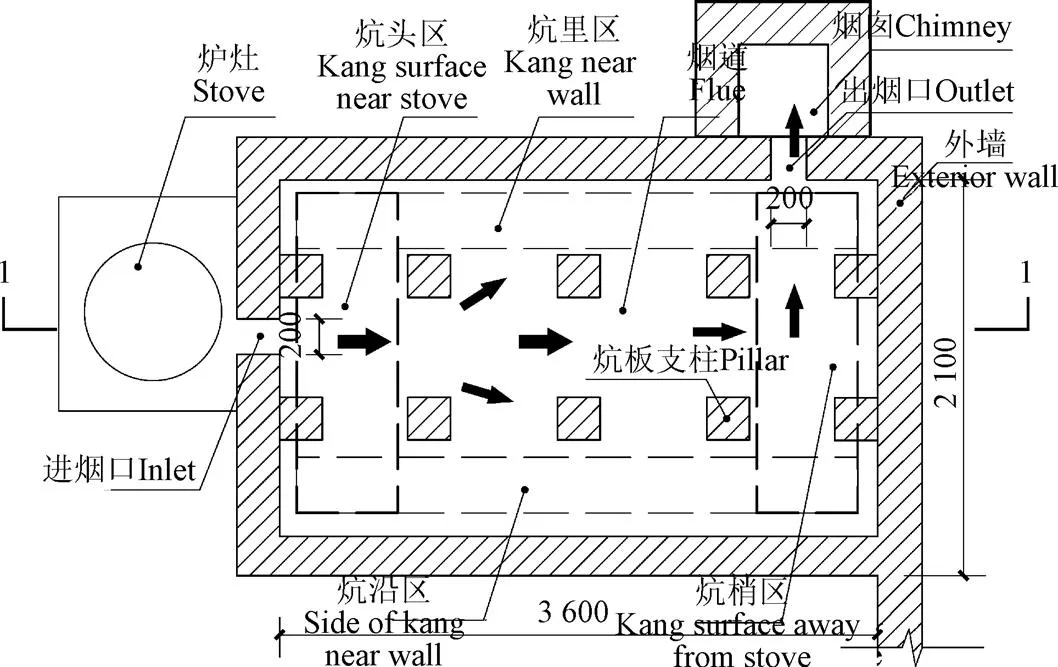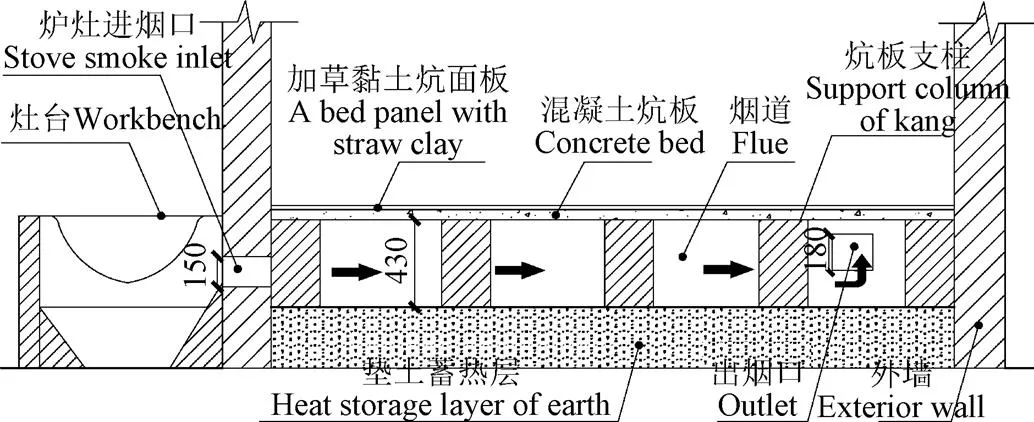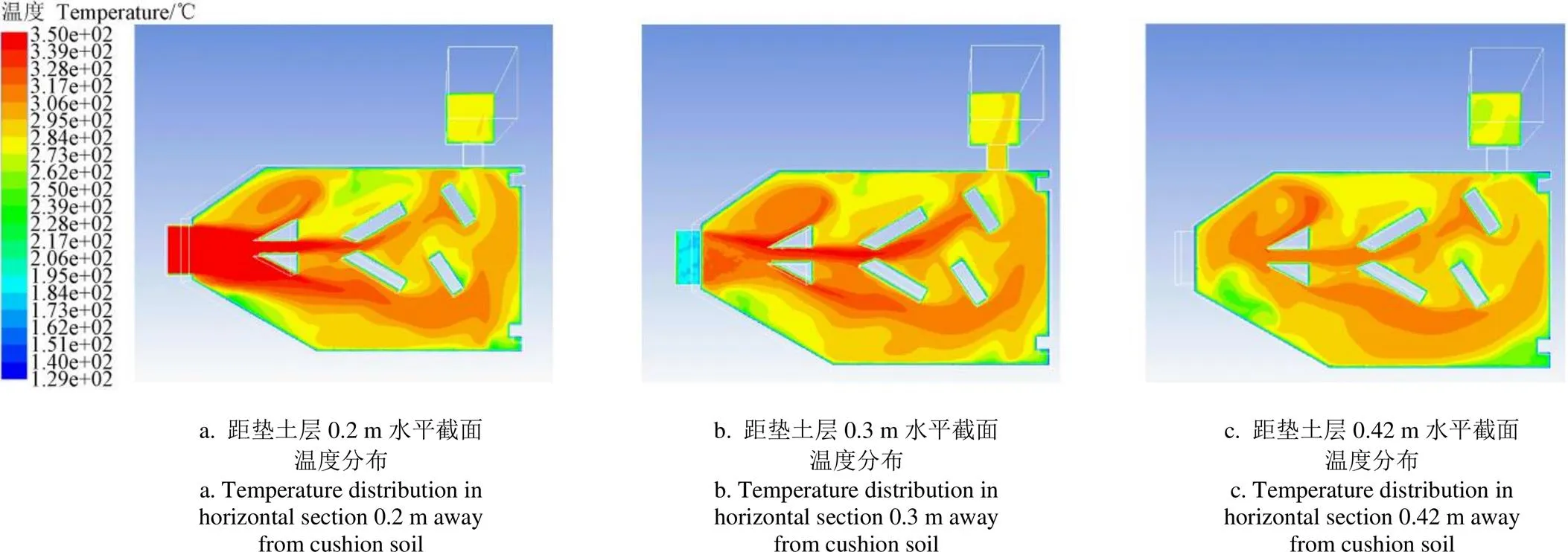基于温度场模拟的大花洞火炕烟道构造形式优化设计
2019-11-11陈丽珠王伟栋
张 杰,陈丽珠,王伟栋
基于温度场模拟的大花洞火炕烟道构造形式优化设计
张 杰,陈丽珠,王伟栋
(内蒙古科技大学建筑学院,包头 014010)
针对内蒙古东部农牧区居住建筑中广泛使用的大花洞火炕普遍存在的炕面温度极不均匀、热效率低的问题,以流体力学和建筑热工知识为指导,遵循前引后导原则对火炕烟道形式进行改进设计。通过对大量新建火炕模型温度场的模拟,精选出改进火炕I和改进火炕II 2种优化方案。利用ANSYS模拟技术对现状大花洞火炕和改进火炕模型的烟气流场、温度分布状况进行模拟分析,结果表明:相比现状火炕,改进火炕I的排烟温度降低了10 ℃左右且接近炕板处高温烟气覆盖面增加了约55%,改进火炕II的排烟温度降低了20 ℃左右且接近炕板处高温烟气覆盖面增加了约40%,改进后的大花洞火炕的烟气流场分布和热效率较现状火炕有明显改善和提升。
温度;流场;优化;大花洞火炕;烟道形式优化;热效率;ANSYS流场模拟
0 引 言
提高农牧民居住环境质量和燃料的使用效率是乡村振兴战略的重要内容之一。作为北方农牧民居住建筑冬季使用的供暖设施之一,其火炕热效率的高低直接影响着燃料的消耗量和居住环境的生活质量。随着人们生活水平的提高和对室内人居环境的重视,国内许多学者对火炕的热效率及其热工性能评价指标进行了大量的试验和研究[1-12]。但针对大花洞火炕这一研究对象,在不改变原有材料和砌筑技术的前提下,通过对炕洞内不同烟道形式对于烟气流场的影响进行ANSYS模拟对比分析温度场、优化烟道构造设计改善烟气流场分布,进而提高火炕热效率的研究还很少。
ANSYS软件具有强大的流体计算分析功能,包括可以求解流体温度分布等问题,并能够直观显示流体的温度变化情况。本文创新地将其用于火炕炕体内部高温烟气的流场分析及热效率研究。
对火炕烟道进行优化设计,利用ANSYS模拟技术模拟,目的是改善火炕烟气流场分布,使接近炕板处的高温烟气分布更加均匀,以提高人们睡觉时的热舒适度,提高火炕的热效率,进而也提高能源利用率。
1 现状火炕模型的建立及热舒适度评价
1.1 现状火炕模型的建立
内蒙古东部属于严寒地区,冬季寒冷且漫长。通过对内蒙古东部地区的热环境参数及部分农村牧区居住建筑火炕使用情况进行的大量调研(表 1)可知,绝大多数家庭使用大花洞落地炕进行室内供暖。火炕主要由提供热源的炉灶、蓄热散热的炕体和用于排烟的烟囱3部分组成,一般由砖砌筑,火炕的炉灶和烟囱位置一般根据居室的平面布局、以符合人们生活习惯且方便使用而确定。
烧灶时,高温烟气从进烟口进入炕体内部,与炕板、支柱、四周炕墙和垫土层进行热量交换后,通过出烟口和烟囱排到室外。现状大花洞火炕模型及内部烟气流动示意如图1所示,调研火炕实体照片见图2。
1.2 炕面板的体感温度及评价
根据《农村火炕系统通用技术规程》(JGJ/T358-2015)中火炕热工性能检测方法,在冬季最冷的1月,选择在下午进行完炊事或单独对火炕进行加热后的六点到九点的时间段内,在火炕的炕头、炕中和炕梢区平均分布9个测点(图3)进行测量,采用温度自动记录仪对炕板外表面温度进行检测记录,时间步长为3 min。对测量温度数据进行每隔30 min的整理,使检测结果能够直观的观察并对比炕头、炕中和炕梢各区域的炕面温度。
测量结果显示,在整个炕面板上,测点1、2、3所处的炕头部分温度普遍偏高,其中测点2位于炕洞的进烟口,所以炕板温度最高;而炕中的测点4、5、6所在位置相对炕头温度大幅度下降,而中间的测点5的温度比两侧测点4、6的温度高;因炕梢距离炕头较远,测点7、8、9的温度普遍偏低。整体来看,炕沿和炕里区域相对炕中部位普遍偏低,给人呈现的体感即为腰部中间热、头脚两头凉;炕头和炕梢区域的温差较大,即为“炕头热、炕梢冷”(图4)。

表1 内蒙古东部部分农村牧区热环境参数及火炕使用情况
注:内蒙古地区建筑热工设计分区:以采暖度日数为依据,6 000≤HDD18为严寒A区(1A),5 000≤HDD18<6 000为严寒B区(1B),HDD18<5 000为严寒C区(1C)。
Note: Inner Mongolia thermal design zone: based on heating days, 6 000≤HDD18 is severe cold zone A (1A), 5 000≤HDD18 < 6 000 is severe cold zone B (1B), and HDD18 < 5 000 is severe cold zone C (1C).

a. 大花洞火炕平面图
a. Floor plan of large complexity kang cave

b. 剖面图

图2 大花洞落地炕实体照片

图3 火炕炕面温度测点布置图

图4 火炕3个区域各个测点的温度
根据人们对热效率最常规的理解,火炕内部吸收的高温烟气热量占总输入热量的百分比即为火炕的热效率,所以通过进出烟口烟气的温度差值可计算出炕体的热效率为

为了重点研究改进大花洞火炕烟道构造形式对烟气流场、温度分布变化的影响规律,只对炕体内烟道布局进行优化设计,不改变人们已经习惯的炉灶和烟囱位置。在不考虑随机影响因素的前提下,炕洞内烟气的扩散程度和火炕进出口处的烟气温度差反映了火炕内吸收热量的多少,进而反映了火炕热效率的高低。
模拟炕洞内部的温度变化,对三维计算模型进行布尔运算,对模拟的温度、压强的边界条件进行设置,将进出烟口烟气压强差值设置在10 Pa左右[13-14],进烟口温度设置为350 ℃[15]。在此工况下分别对改进前后模型进行模拟分析。
为全面分析火炕内高温烟气的流动状态、温度分布及温度变化情况,选取了不同标高的3个水平截面进行研究:
1)烟道内部距垫土层0.2 m的水平截面,以分析高温烟气通过进烟口进入炕洞内部后的烟气流场分布情况;
2)距垫土层0.3 m的出烟口中心水平截面,以研究高温烟气在炕洞内的流动情况和出烟口的温度分布;
3)距垫土层0.42 m的接近炕板底部水平截面,以分析高温烟气与炕板的热交换效率,所选3个水平截面见图5。

图5 火炕内部热量截面示意图
2 现状火炕模拟及分析
图6给出了现状火炕内部各水平截面烟气的温度分布模拟图,从图6a看出,高温烟气作为热载体进入炕洞内部,主要集中在炕洞入口附近,很少向其他区域扩散,这与试验数据反映的结果相吻合,热量主要集中在炕头部分,被人们有效利用的热量很少。图6b显示,出烟口温度分布在280 ~300 ℃之间,说明在炕洞内被炕体吸收了50 ~70 ℃的热量,根据公式(1),现状火炕的热效率大约为14%~20%;将接近炕板处270 ℃以上的烟气分布面积占整个炕板面积的比例作为评判流场均匀性和与炕板热交换效率的指标之一。在图6c中,其面积占炕板面积的25%左右,高温烟气在炕洞中即时向炕板传递的热量较少,导致炕板整体升温的速度偏低,要达到人们日常的基本温度需求,就必然要燃烧更多的燃料。

图6 现状火炕内部不同截面烟温分布图
3 火炕烟道构造的优化设计及模拟
3.1 火炕烟道构造的优化设计
现状火炕的炕洞内支柱布置形式虽然较为规整,但存在烟气过于集中,热量很少向整个炕板的其他区域扩散,导致炕面板的温度分布不均匀。从提高烟气流场均匀性的目的出发对火炕进行改进,仅改进炕洞内支柱的布置方式,使烟气在整个炕洞内均匀分布并向炕板传递热。通过对大量改进火炕模型的温度场对比分析,精选出图7中a、b 2个火炕优化模型,其烟气流场分布有明显的改善。在距进烟口内侧约900 mm且略偏上位置用砖砌尖形迎火墙(也是炕板支柱)对进入炕洞的烟气起到引流或分流作用,目的是使烟气的流场能分布于较大区域。在迎火墙后烟气流经路径上设置倾斜式分烟墙和导烟墙,目的是对流动的烟气起到导流作用,使高温烟气在炕洞内尽可能流过更大区域、停留更长时间,使烟气更加充分地与炕面板进行热量的交换传递。

图7 大花洞火炕优化构造设计模型
3.2 改进火炕模拟分析
在相同工况下,对改进火炕I进行模拟(图8)。从图8a中可以看出,高温烟气进入炕洞后,在三角形迎火墙、分烟墙和导烟墙的作用下,烟气流场范围不断扩大;图8b显示,出烟口温度分布在270 ~280 ℃之间,在炕洞内被炕体吸收了70 ~80 ℃的热量,由公式(1)计算得出,改进火炕I的热效率大约为20%~22%;高温烟气在火炕内明显扩散且使炕板的温度分布更加均匀,说明高温烟气即时向炕板传递的热量(图8c)较现状火炕整体有了明显的提高。接近炕板处270 ℃以上的烟气分布面积占炕板面积的80%,说明改进火炕I在利用同等燃料的前提下,高温烟气能够更好的被炕板有效吸收利用。
对图7b火炕的模拟结果如图9所示。设置尖劈形迎火墙、分烟墙和后导烟墙扩大烟气流场(见图9a),使高温烟气尽可能的分散于整体炕洞,增大烟气与炕板的接触面积。从图9b可知,出烟口处温度在265 ~280 ℃之间,计算求得,改进火炕II的热效率约为20%~24%;图9c中接近炕板处270 ℃以上的烟气分布面积占炕板面积的65%。

表2 3种火炕热工性能对比分析

图8 改进火炕I内部不同截面烟温分布图

图9 改进火炕II内部不同截面烟温分布图
通过分析可以看出低温面积区大部分分布在炕沿区域,据人们日常睡眠生活习惯,炕沿区域是头部所在位置,由人体热工知识,头凉脚热对人体来讲是较为热舒适的状态且有益于健康,相比现状火炕,接近炕板的高温烟气有所提升且符合人们日常生活睡眠的热舒适需求。
3 结 论
基于流体力学和热工学知识,利用ANSYS模拟技术对大花洞火炕内烟气流场及火炕热效率进行了模拟分析研究,得出如下结论:
1)传统大花洞火炕烟气流场主要集中于火炕中轴区域,流场范围狭小,局部高温导致对流换热强度减小,对高温烟气热量利用率低,排烟温度较高。
2)对火炕的烟道构造进行优化设计,提高接近炕板处烟气温度,高温烟气的流场分布扩大,均匀性明显改善,且使高温烟气更大范围地接触炕板使炕板充分吸热,能降低出烟口的排烟温度,大幅提升了火炕的热效率。
3)改进火炕I的炕板温度整体提高,更适合类似老年人睡眠时对整体炕面温度有较高要求的人群;改进火炕II的炕板高温覆盖面提高,更适合睡眠时对炕面温度均匀性有较高要求的人群。
4)ANSYS模拟技术为改进火炕的热效率研究提供了一种新的模拟方法和技术支持,也为新型火炕的砌筑提供了指导。
[1] 徐策,王宗山,端木琳. 炕面温度非均一的火炕热传递模型[J]. 建筑热能通风空调,2016,35(1):19-22,73. Xu Ce, Wang Zongshan, Duan Mu Lin. The heat transfer mode of chinese kang with a non-uniform temperature[J]. Building Energy & Environment, 2016, 35(1): 19-22, 73. (in Chinese with English abstract)
[2] 徐策. 火墙式火炕热性能实验研究及传热模型的建立[D]. 大连:大连理工大学,2015. Xu Ce. Experiment Research on Thermal Properties and the Establishment on Heat Transfer Model Of Hot-Wall Kang[D]. Dalian: Dalian University of Technology, 2015. (in Chinese with English abstract)
[3] 方修睦,王芳,李桂文,等. 火炕热工性能评价指标及检测方法研究[J]. 建筑科学,2014,30(6):119-123. Fang Xiumu, Wang Fang, Li Guiwen, et al. Study on evaluation index and test method of thermal performance of kang[J]. Building Science, 2014, 30(6): 119-123. (in Chinese with English abstract)
[4] 王丹,徐聪智,李桂文,等. 改善火炕炕面温度分布技术模拟[J]. 哈尔滨工业大学学报,2012(4):75-79. Wang Dan, Xu Congzhi, Li Guiwen, et al. Simulation study on the technology for improving the temperature distribution of Kang surface[J]. Journal of Harbin Institute of Technology, 2012, 44(4): 75-79. (in Chinese with English abstract)
[5] Chen B, Zhuang Z, Chen X, et al. Field survey on indoor thermal environment of rural residences with coupled Chinese kang and passive solar collecting wall heating in Northeast China[J]. Solar Energy, 2007, 81(6): 781-790.
[6] Zhuang Z, Li Y, Chen B, et al. Chinese kang as a domestic heating system in rural northern China: A review[J]. Energy and Buildings, 2009, 41(1): 111-119.
[7] 李刚,池兰,冯国会,等. 相变蓄能火炕热舒适性的试验[J].农业工程学报,2016(11):244-249. Li Gang, Chi Lan, Feng Guohui, et al. Experiment on thermal comfort performance of phase-change energy storage Kang[J]. Transactions of the Chinese Society of Agricultural Engineering (Transactions of the CSAE), 2016, 32(11): 244-249. (in Chinese with English abstract)
[8] 郝亚芬,敖永安,端木琳,等. 火墙式火炕内烟气流动特性数值模拟分析[J]. 建筑节能,2014,42(8):8-12. Hao Yafen, Ao Yong'an, Duan Mulin, et al. Numerical simulation analysis of the smoke flowing characteristics within huo-kang with hot-wall[J]. Building Energy Efficiency, 2014, 42(8): 8-12. (in Chinese with English abstract)
[9] 牛叔文,钱玉杰,胡莉莉等. 甘肃庄浪县农户吊炕的热效率模拟分析[J]. 农业工程学报,2013,29(6):193-201. Niu Shuwen, Qian Yujie, Hu Lili, et al. Model analysis on thermal efficiency of suspended Kang of rural households in Zhuanglang county, Gansu province[J]. Transactions of the Chinese Society of Agricultural Engineering (Transactions of the CSAE), 2013, 29(6): 193-201. (in Chinese with English abstract)
[10] 张腾. 严寒地区火炕农宅冬季睡眠环境热舒适现场研究[D].哈尔滨:哈尔滨工业大学,2018. Zhang Teng. Field study of thermal comfort in sleeping environment in winter at rural houses with kang in severe cold region[D]. Harbin: Harbin Institute of Technology, 2018. (in Chinese with English abstract)
[11] 许景茗,夏楠,邢凯. 东北严寒地区村镇住宅低能耗火炕设计[J]. 低温建筑技术,2016,38(1):11-13. Xu Jingming, Xia Nan, Xing Kai. Low-energy kang design for rural residential buildings in severe cold region of northeast China[J]. Low Temperature Building Technology, 2016, 38(1): 11-13. (in Chinese with English abstract)
[12] 李刚,于玺,庞凯,等. 复合热源工况相变蓄热炕面板性能模拟分析[C]. 第十四届沈阳科学学术年会论文集(理工农医). 中共沈阳市委、沈阳市人民政府、沈阳市科学技术协会,2017. Li Gang, Yu Xi, Pang Kai, et al. Performance simulation analysis of phase change storage kang panel under composite heat source condition[C]. Proceedings of the 14th shenyang scientific and technological annual conference (science, industry, agriculture and medicine). Shenyang Municipal Party Committee, Shenyang Municipal People's Government/ Shenyang Association for Science and Technology, 2017. (in Chinese with English abstract)
[13] 许圣华. 烟气物性的直接计算方法[J]. 苏州丝绸工学院学报,1999,19(3):32-36. Xu Shenghua. Direct calculation of flue GAS properties[J]. Journal of Suzhou Institute of Silk Textile Technology, 1999, 19(3): 32-36. (in Chinese with English abstract)
[14] 赵洋. 北方村镇火墙式火炕采暖系统热性能研究[D]. 大连:大连理工大学,2009. Zhao Yang. Study on the Thermal Performance of the Heating System of Wall in the Northern Village[D]. Dalian: Dalian University of Technology, 2009. (in Chinese with English abstract)
[15] 陈荣耀,吕良. 炕连灶技术讲座(二)[J]. 可再生能源,1987(03):30-31. Chen Rongyao, Lü liang. Technical lecture of kang with stove(2)[J]. Renewable energy, 1987(3): 30-31. (in Chinese with English abstract)
Flue form optimization design of large complexity kang based on temperature field simulation
Zhang Jie, Chen Lizhu, Wang Weidong
(,,014010,)
With economic development and living standard improving in China, the demand by people in rural areas for thermal conformity of indoor facilities in their homes has also increased. This has become one of the main targets in rural revitalization in the country. In rural grassland areas in northern China, brick-bed (Kang) has been widely used by farmers and herdsmen as an integrated system for sleeping and heating in winter. Different kangs exist in different areas, but most of them are built with experiences and lack of temperature uniformity, giving rise to uncomfortable sleeping and poor thermal efficiency. Effectively combining natural and existing conditions to make the kang more thermally comfortable and energy efficiency is hence a key issue but has been overlooked. This paper aims to address this gap by re-designing the pathways of the smoke and flue gas in the kang using CFD software ANSYS. The smoke wall and the guide were re-set based on the principle of “front and rear guide” in that the smoke walls should make the distribution of the smoke flow improve thermal conformity and thermal efficiency. We compared two re-designed kangs and simulated the distribution of the flue gas temperature in each using ANSYS. The results show that, compared with the traditional kang, the design I reduced the exhaust smoke temperature by about 10 ℃ and increased the coverage of high-temperature flue gas in the proximity of the kang plate by about 55%. These combine to improve the temperature uniformity. For the design II, the associated reduction in the temperature and increase in high temperature coverage was 20 ℃ and 40% respectively. In summary, the flue optimization in the both designed kangs improved the spatial distribution of the smoke flow and thermal efficiency, compared to the traditional one; they also increased the temperature of the flue gas in the vicinity of the raft and adsorbed more heat of the high-temperature flue gas to the slab, thereby increasing the temperature of the slab and reducing smoke loss. All these show that the new designs significantly improved the thermal efficiency of the kang, in which the flue gas can get into the chimney flue and the kang panel through thermal absorbing and storing. They also enhance the release of the flue gas heat to improve thermal conformity within a wide range of high temperature. ANSYS is a tool that can be used to improve design of thermal-efficient kang.
temperature; flow field; optimization; large complexity kang; flue form optimization;thermal efficiency; ANSYS flow field simulation
2019-05-24
2019-08-25
国家自然科学基金项目(51668051);国家自然科学基金项目(51868060)
张 杰,教授,主要从事建筑节能、建筑物理教学与研究。Email:zhangjieav@163.com.
10.11975/j.issn.1002-6819.2019.17.028
TU832
A
1002-6819(2019)-17-0233-07
张 杰,陈丽珠,王伟栋.基于温度场模拟的大花洞火炕烟道构造形式优化设计[J]. 农业工程学报,2019,35(17):233-239. doi:10.11975/j.issn.1002-6819.2019.17.028 http://www.tcsae.org
Zhang Jie, Chen Lizhu, Wang Weidong. Flue form optimization design of large complexity kang based on temperature field simulation[J]. Transactions of the Chinese Society of Agricultural Engineering (Transactions of the CSAE), 2019, 35(17): 233-239. (in Chinese with English abstract) doi:10.11975/j.issn.1002-6819.2019.17.028 http://www.tcsae.org
